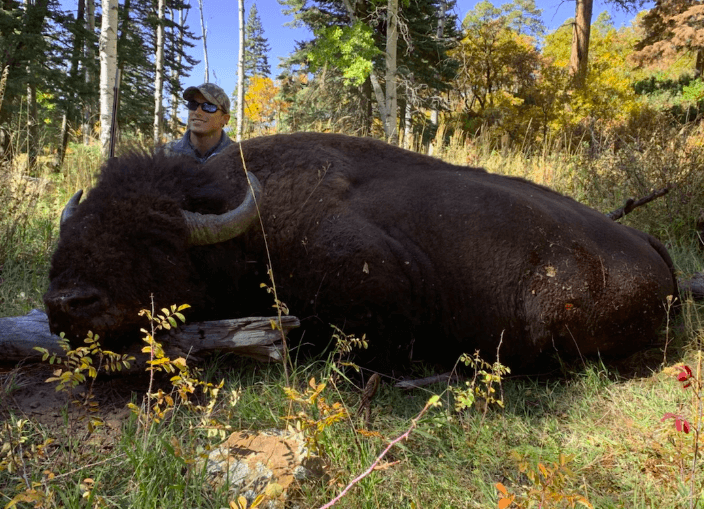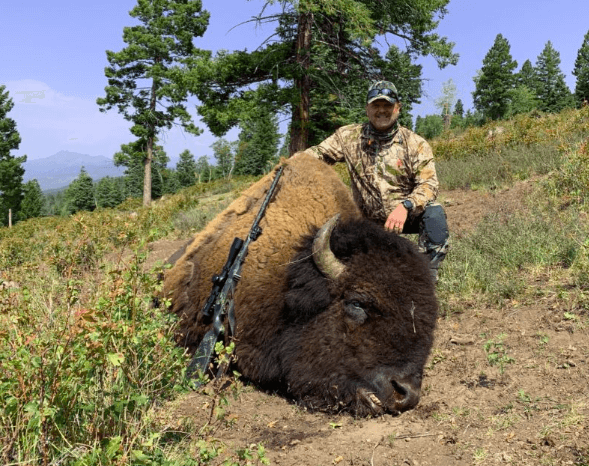
14 Best Bison hunting states.
Buffalo hunting, also known as bison hunting, is a fascinating and difficult sport that draws hunters from all over the world. While American bison historically roamed huge expanses of North America, their populations were significantly diminished in the past owing to overhunting.
Regulated hunting is now permitted in certain states where bison populations have been effectively regenerated. In this comprehensive guide, we will look at the top buffalo hunting states in the United States, offering full information about each state, hunting rules, accessible outfitters, and other pertinent information.
Here is a list of Best Bison/ Buffalo Hunting States:
1. Wyoming:
Wyoming has some of the largest free-roaming bison herds in the country. The state has both public and private hunting areas. A lottery method is used for public hunts, while private outfitters provide guided hunts on big ranches. Although the Yellowstone and Grand Teton National Parks are famous for their bison populations, hunting is prohibited within park limits. Wyoming’s wide landscapes and harsh terrain make it a favourite destination for buffalo hunters. More on Wyoming bison hunts
2. Montana:
Montana has a sizable bison population, which is largely located in Yellowstone National Park and on state and tribal territories. The state provides limited public hunting possibilities, and tag allotment is determined by a draw mechanism.
Private outfitters also exist in Montana, offering guided hunts on private ranches. The hunting season is often held throughout the winter months, which can bring unique obstacles and an exciting experience for hunters. Read more on bison hunts Montana.
3. South Dakota:
South Dakota is well-known for its many hunting options, which include bison hunts. Through a restricted draw system, the state provides public hunting on designated properties. Private outfitters also offer guided hunts on huge ranches. Custer State Park, in particular, is famous for its iconic bison herds and provides a one-of-a-kind hunting experience. South Dakota’s stunning scenery and the opportunity to hunt bison in a pure natural habitat make it an appealing hunting location.
4. Alaska:
The Wood Bison, a bigger subspecies of bison, lives in Alaska. The state offers little hunting possibilities for Wood Bison, with just a few licences accessible through a lottery system.
These hunts are governed by the Alaska Department of Fish and Game. Wood bison hunting in Alaska is a very distant and demanding excursion in the Last Frontier.
5. North Dakota:
North Dakota is another state with few prospects for bison hunting. A lottery is held by the state for a limited number of public tags, particularly in Theodore Roosevelt National Park. On certain ranches, private outfitters also provide guided hunts. The bison hunts in North Dakota are extremely competitive, and obtaining a tag may be difficult. However, the state’s stunning scenery and the opportunity to hunt in a unique habitat make it a desired buffalo hunting location.
6. Colorado:
A few private ranches in Colorado provide bison hunting chances. While there are no wild bison herds in the state, these private ranches continue breeding programmes to keep populations healthy. Hunters may schedule guided hunts on these ranches, giving them the opportunity to experience the excitement of the hunt.
7. Utah:
Utah’s bison restoration efforts have been effective, and the state provides restricted hunting opportunities for both citizens and non-residents. The Utah Division of Wildlife Resources supervises the hunts and assigns tags using a lottery method. Private outfitters also offer guided hunts on private property.
The Henry Mountains in Utah are famous for its free-roaming bison herd, which provides a hard and gratifying hunting experience.
8. New Mexico:
Several private ranches in New Mexico provide buffalo hunting possibilities. These ranches keep bison herds and provide guided hunts to sportsmen. The state’s varied landscapes, which include mountains, deserts, and grasslands, provide a unique setting for hunting expeditions.
9. Arizona:
A few private ranches in Arizona provide buffalo hunting opportunities. These ranches keep bison herds and provide guided hunts. The state’s diverse desert landscapes and rocky terrain make for an unforgettable setting for hunting expeditions.
10. Texas:
Texas is famous for its enormous private ranches, and some of them provide buffalo hunting opportunities. These ranches keep bison herds and provide guided hunts. The state’s moderate temperature and varied topography make it a popular hunting destination. It’s important to remember that hunting restrictions and seasons may change from state to state, so check with outfitters and state wildlife organisations for the most up-to-date information.
11. Oklahoma:
Oklahoma is another state where private ranches provide buffalo hunting. These ranches primarily keep bison herds and provide sportsmen with guided hunts. Oklahoma’s diversified hunting terrain is made up of grasslands, woodlands, and agricultural areas.
12. Idaho:
Idaho has little options for buffalo hunting. In certain locations, the state conducts a regulated bison hunt. These hunts are strictly controlled, and successful applicants will have the opportunity to pursue bison in Idaho’s magnificent landscapes.
13. Oregon:
On private grounds in Oregon, there are few options for buffalo hunting. Outfitters in the state provide guided hunts on farms with bison herds. The different settings of Oregon, from mountains to high desert, provide for an exciting hunting experience.
14. Arizona:
A few private ranches in Arizona provide buffalo hunting opportunities. These ranches keep bison herds and provide guided hunts. The state’s diverse desert landscapes and rocky terrain make for an unforgettable setting for hunting expeditions.
It’s important to note that hunting restrictions, tag availability, and hunting seasons are subject to change, so make sure to check with state wildlife agencies and outfitters for the most up-to-date information.
Furthermore, it is critical to respect and follow all hunting restrictions and standards in order to guarantee the protection of these unique animals.
Buffalo hunting offers a once-in-a-lifetime opportunity to experience the excitement of the chase while also connecting with North America’s rich heritage.
Each state has its own different landscapes, hunting possibilities, and problems, so hunters must research and select the state that best fits their tastes and ambitions.
Whether you like Wyoming’s enormous plains, Alaska’s rough wilderness, or Kansas’ rolling grasslands, buffalo hunting in the United States guarantees a once-in-a-lifetime encounter.
How much meat do you get from 1 bison?

The quantity of meat you can receive from a single bison depends on a number of factors, including the animal’s size, the cuts of meat wanted, and the butchering method.
A completed bison carcass may provide 400 to 600 pounds (181 to 272 kilogrammes) of meat on average. It is crucial to remember, however, that this is an estimate, and the real yield may differ.
When a bison is processed for meat, it is butchered and deboned to separate the various parts. Meat cuts are often divided into the following categories:
Steaks:
The most attractive cuts of bison meat, such as ribeye, T-bone, sirloin, and fillet mignon, are frequently utilised for steaks.
Roasts:
Larger cuts of bison, like as chuck roasts or shoulder roasts, are ideal for slow cooking methods such as braising or pot roasting.
Ground Meat:
Ground bison is a popular choice that can be used in a variety of recipes such as burgers, meatballs, chilli, and stir-fries.
Ribs:
Bison ribs can be prepared in the same way as beef ribs are, by grilling, smoking, or slow roasting.
Offal:
Some people choose to use bison offal, such as the liver, heart, or tongue, which may be prepared and eaten as unique gourmet alternatives.
Keep in mind that the proportion of meat produced from a bison carcass varies according on the cuts used, the butcher’s competence, and the quantity of trim (fat removal). Furthermore, if you prepare the entire animal, including the bones and organs, you may achieve a larger total weight but a smaller proportion of meat.
Why Choose Bison Over Beef?

There are various reasons why people prefer bison (or buffalo) meat to beef. Here are some of the major aspects that contribute to bison’s popularity:
Nutritional Advantages:
Because of its nutritional makeup, bison meat is sometimes seen as a better alternative to beef. When compared to beef, bison meat is often leaner and lower in fat, calories, and cholesterol. It is also high in protein, iron, zinc, and omega-3 fatty acids.
Taste and flavour:
Many people believe that bison meat has a particular flavour. It is frequently regarded as having a little sweeter, richer, and more strong flavour than beef. Bison’s flavour characteristic may be linked to its grass-fed and free-range diet, which results in a more pronounced and natural flavour.
Environmental Considerations:
In comparison to beef, bison is seen to be a more sustainable and ecologically beneficial meat option. Bison are well-adapted to grass grazing and may survive on natural forage, decreasing the need for grain-based feed. Furthermore, by their grazing habits, bison play an important role in sustaining healthy grasslands.
Ethical Considerations:
Some people prefer bison meat owing to ethical concerns about animal welfare. In comparison to highly cultivated beef cattle, bison are frequently raised in more natural and free-range habitats. Bison are often not given growth hormones or antibiotics, allowing their natural behaviour to develop.
Cultural and Historical Significance:
Bison are culturally and historically significant, particularly in Native American tribes. Choosing bison meat is one way to honour and support the preservation of this unique creature and its cultural history.
It’s worth noting that personal tastes, dietary concerns, and availability may all impact a person’s decision to eat bison instead of beef.
Furthermore, while bison meat has several advantages, it is still critical to get it from reliable suppliers that adhere to sustainable and ethical practises to ensure the meat’s quality and integrity.
Are bison a cross between cows and buffaloes?

Bison (also known as American buffalo) are not a cross between a cow and a buffalo. Bison and cows (domestic cattle) are two independent animals with distinct genetic backgrounds.
Bison (Bison bison) are ruminant animals that are members of the Bovidae family, which also includes cows, sheep, goats, and other ruminant mammals. Bison are categorised as a genus under the Bovidae family. Bison are classified into two subspecies: plains bison (Bison bison bison) and wood bison (Bison bison athabascae).
Cows, on the other hand, are members of the Bos genus. Bos taurus is the most prevalent domestic cow species, which comprises a variety of breeds that have been deliberately selected for specific features over decades.
While bison and cows are related and share certain physical traits as members of the Bovidae family, they are separate animals with unique genetic makeup and morphological characteristics. Bison have a stronger body, thicker fur, a hump on their shoulders, and prominent horns. Cows vary in size, coat colour, and horn form according on the breed.
The earlier noted usage of the word “buffalo” to denote American bison may have contributed to the misunderstanding between bison and cows. Bison and cows, on the other hand, are distinct species with distinct biological and ecological traits.
Why are bison referred to as Buffalo?

In North America, the name “buffalo” is widely used to refer to bison. The early European immigrants who discovered the huge, hairy beasts on the American continent were responsible for the name misunderstanding.
Because they were unfamiliar with the animal’s exact taxonomy, these settlers identified it with the buffalo they had seen in Europe and other areas of the world.
True buffalo species, such as water buffalo and African buffalo, are endemic to various places and differ from American bison (Bison bison).
Despite variations in taxonomy, appearance, and behaviour, early European immigrants described to the American bison as “buffalo” because it resembled the buffalo they were familiar with.
FAQs About Hunting:
Which states in the USA are known for bison/buffalo hunting?
Some of the states known for bison/buffalo hunting include Montana, Wyoming, South Dakota, North Dakota, Colorado, and Alaska.
What permits or licenses are required to hunt bison/buffalo?
A bison/buffalo hunting license or permit is typically required, which may include additional tags or stamps specific to bison.
Are there specific seasons for bison/buffalo hunting in each state?
Yes, each state usually has designated hunting seasons for bison/buffalo, which can vary depending on the location and population management goals.
What is the average cost of a bison/buffalo hunting license?
The cost of a bison/buffalo hunting license varies by state and can range from several hundred to several thousand dollars.
Non-residents may shoot bison and buffalo in these states.
Non-residents may hunt bison/buffalo in these states, but they may have to pay additional costs or get special licences.
Non-residents may shoot bison and buffalo in these states.
Non-residents may hunt bison/buffalo in these states, but they may have to pay additional costs or get special licences.
Are there any limits on the sorts of weapons that may be used to hunt bison/buffalo?
Each state may have different laws regulating the sorts of weapons that are permitted, which may include rifles, shotguns, or archery equipment.
Are guided bison/buffalo hunts available?
Yes, guided hunts for bison/buffalo are frequently available, and many outfitters and ranches provide guided hunting excursions.
Non-residents may shoot bison and buffalo in these states.
Non-residents may hunt bison/buffalo in these states, but they may have to pay additional costs or get special licences.
Non-residents may shoot bison and buffalo in these states.
Non-residents may hunt bison/buffalo in these states, but they may have to pay additional costs or get special licences.
Are there any limits on the sorts of weapons that may be used to hunt bison/buffalo?
Each state may have different laws regulating the sorts of weapons that are permitted, which may include rifles, shotguns, or archery equipment.
Are guided bison/buffalo hunts available?
Yes, guided hunts for bison/buffalo are frequently available, and many outfitters and ranches provide guided hunting excursions.
How difficult is it to hunt bison/buffalo in comparison to other big game?
Because of their size, strength, and strong senses, bison and buffalo hunting can be difficult. It takes meticulous preparation, physical stamina, and precise shot placement.
How successful are bison/buffalo hunts in these states?
The success rate of bison/buffalo hunts varies based on a number of factors, including hunting abilities, experience, and population density. Success rates might range between 30% and 70%.
Are there any additional rules or restrictions while hunting calves or mature bulls?
Yes, there may be special laws and constraints surrounding the harvesting of calves or adult bulls in order to ensure the population’s long-term management.
Are there any approved hunting tactics or strategies for bison/buffalo?
Spot-and-stalk, ambush, or guided hunts with expert outfitters are typical ways for bison/buffalo hunting.
Are there any bison/buffalo conservation efforts or quotas in place?
Yes, conservation initiatives and quotas are in place to maintain the long-term management of bison and buffalo populations and to prevent overharvesting.
What are the consequences of hunting bison/buffalo without the necessary licences or permits?
Hunting bison/buffalo without the proper licences or permissions can result in substantial penalties such as fines, licence suspension, and legal ramifications.
Can I utilise the flesh and skin of a bison/buffalo that has been harvested?
Yes, the flesh from a harvested bison/buffalo is valuable and may be consumed. The hide is tanned.
Is there an additional expense to processing and transporting harvested bison/buffalo?
Yes, there may be additional charges for field dressing, slaughtering, packaging, and shipping of the meat, which are usually managed by the hunter or a local processor.
Is it illegal to transport bison/buffalo meat or trophies out of the state?
Specific rules and limitations, such as inspections, permits, or paperwork requirements, may apply when exporting bison/buffalo meat or trophies out of the state.
Are any health precautions or testing necessary while preparing bison/buffalo meat?
Bison/buffalo meat is typically safe to ingest, although basic food safety practises should be followed. Specific testing for illnesses such as brucellosis may be required in some areas.
Conclusion.
Finally, the United States has a number of outstanding states for Best bison/buffalo hunting, giving hunters with thrilling and unique encounters. These states have flourishing bison herds and well-managed hunting opportunities, from the broad plains of Montana and Wyoming to the harsh terrain of South Dakota and North Dakota.
Each state has its own restrictions, seasons, and permission procedures, so hunters must become acquainted with the precise guidelines before beginning on their expedition. Many places provide guided hunts, which provide professional guidance and increase the likelihood of a successful hunt.
Best Bison/buffalo hunting necessitates talent, patience, and awe for these magnificent beasts. It is an opportunity to reconnect with nature, learn about the rich heritage of the American West, and help the environment.
Similar posts.
- Buffalo Hunts in New Mexico. One of the most exhilarating hunting experiences.
- Unleashing The Thrills of Black Bear Hunting in Alaska.
- An Exciting Outdoor Activity. Bear Hunting In New York.
- Ultimate Guide To Arkansas Bear Hunting: Tips, Regulations, Best Locations.
- Moose Hunting in Vermont’s Breathtaking Wilderness; Majestic Pursuits





